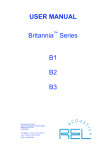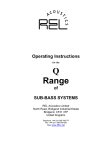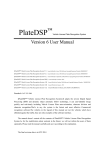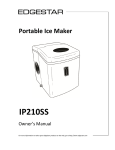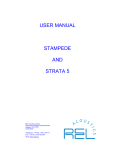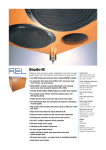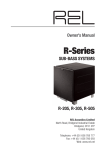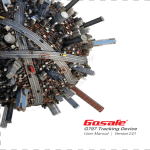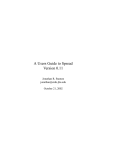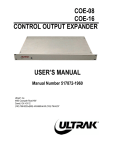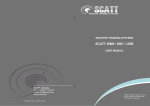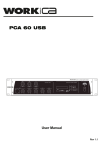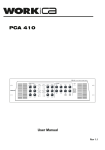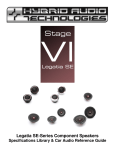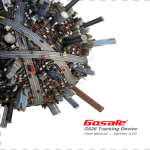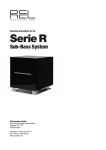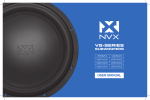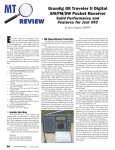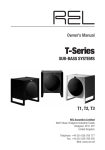Download New ST manual 5 Mar2003
Transcript
Operating Instructions for the ST III Range of SUB-BASS SYSTEMS REL Acoustics Limited North Road, Bridgend industrial Estate Bridgend, CF31 3TP United Kingdom Telephone: +44 (0)1 656 768 777 Fax: +44 (0) 1 656 766 093 Web: www.REL.net REL Acoustics ‘ST III’ User Manual First Printed March 4th 2003 2 REL Acoustics ‘ST III’ User Manual Contents CONTENTS ..................................................................................................................................... 3 IMPORTANT SAFEGUARDS ........................................................................................................ 4 WARNING ....................................................................................................................................... 4 WELCOME...................................................................................................................................... 5 WORLD WIDE WARRANTY ........................................................................................................ 5 SERVICE AFTER WARRANTY................................................................................................... 5 DESIGN SAFETY............................................................................................................................ 6 IMPORTANT ................................................................................................................................ 6 MAIN FEATURES OF REL STRATA III, STORM III, STADIUM III, STENTOR III AND STUDIO III SUB- BASS SYSTEMS................................................................................................ 7 CONTROL PANEL ......................................................................................................................... 8 CONTROLS AND CONNECTIONS............................................................................................... 9 CONTROLS AND CONNECTIONS (CONT ) ............................................................................... 10 CONTROLS AND CONNECTIONS (CONT ) ............................................................................... 11 CONNECTING UP ........................................................................................................................ 12 TO CONNECT TO THE POWER AMPLIFIER USING THE UNBALANCED NEUTRIK HIGH LEVEL INPUT ... 12 TO CONNECT TO MONO BLOCK POWER AMPLIFIERS USING THE HIGH LEVEL NEUTRIK UNBALANCED INPUT ................................................................................................................. 13 TO CONNECT TO DIFFERENTIAL (BALANCED OUTPUT ) POWER AMPLIFIERS USING THE BALANCED HIGH LEVEL INPUT ......................................................................................................................... 14 TO CONNECT TO THE AMPLIFIER/PROCESSOR USING THE PHONO TO PHONO LOW LEVEL INTERCONNECT .................................................................................................................................................... 15 ALTERNATIVE METHOD FOR CONNECTING AT LOW LEVEL FROM PRE AMPLIFIER .............................. 16 TO CONNECT TO A PRE AMPLIFIER WITH LOW LEVEL DIFFERENTIAL (BALANCED) OUTPUTS ............... 17 REL SET-UP MADE SIMPLE ...................................................................................................... 18 REL SET-UP MADE SIMPLER ................................................................................................... 21 RUNNING IN ................................................................................................................................. 22 OVERLOAD PROTECTION........................................................................................................ 22 CARE AND POLISHING .............................................................................................................. 22 TECHNICAL ................................................................................................................................. 23 POWER SAVING EFFICIENCY.................................................................................................. 24 TECHNICAL SPECIFICATIONS STRATA III, STORM III AND STADIUM III .................... 25 TECHNICAL SPECIFICATIONS STENTOR III AND STUDIO III.......................................... 26 3 REL Acoustics ‘ST III’ User Manual IMPORTANT SAFEGUARDS 1. Read all of these instructions. 2. Save these instructions for future use. 3. Unplug from the wall socket before cleaning. Do not use liquid cleaners or aerosol cleaners. Use a damp cloth for cleaning. 4. Do not use near water. 5. Do not place on a stand or table it may fall causing injury to a child or adult, and damage to the unit. 6. The unit should only be operated from the power source indicated on the panel of the amplifier. 7. Only use the power cord supplied. 8. Do not allow anything to rest on the power cord. Position the power cord such that it can not be walked on. 9. For added protection during a lightening storm, or when not in use for long periods of time, unplug it from the wall socket. 10. Never spill any kind of liquid on the unit. 11. Do not attempt to service the unit yourself, as removing the amplifier may expose you to dangerous voltages. Refer all servicing to your dealer. 12. Unplug the unit from the wall socket and refer servicing to your dealer under the following conditions: a. b. c. d. e. When the power cord or plug is damaged. If liquid has been spilled onto the unit. If the unit does not operate properly by following the operating instructions. If the unit has been dropped and damaged. When the unit exhibits a drastic change in performance. WARNING This item is heavy. To avoid risk of injury, take care when handling. 4 REL Acoustics ‘ST III’ User Manual WELCOME Thank you for buying a REL “ST” range Sub-Bass system. Our “ST” range is carefully hand built using the finest materials available and is designed for maximum performance. This manual contains important safety information as well as helpful advice and should be carefully studied before connecting up. WORLD WIDE WARRANTY In addition to any local Warranty, REL offer a 3-year conditional Worldwide Warranty to the end user. It is done in collaboration with our Distributors. The conditions of this Warranty are: 1. 2. 3. 4. 5. 6. 7. That REL receive the necessary registration details from the end user. That these details are received within six weeks of purchase. That the product is not exported from the country of purchase for at least eight weeks after purchase. That any claim is accompanied by the necessary proof of purchase. That it shall be for a term of 3 years from the date of purchase. That the product has not been abused or modified in any way. That it was purchased originally from a REL authorised dealer. This Warranty is offered in good faith and is in addition to any statuary rights or existing Warranty that may be available to the end user. Should your REL Sub Bass Unit give you a problem, please contact your dealer who will be able to make whatever arrangements are necessary to correct it. SERVICE AFTER WARRANTY Please contact your dealer in the first instance before returning any product directly to us. Should the unit need to be returned for any reason, all carriage costs will be payable by the customer. Losses or damage caused during transit are the customer's risk. 5 REL Acoustics ‘ST III’ User Manual DESIGN SAFETY This apparatus is designed to Class II specification and is double insulated, therefore it does not require to be earthed. This apparatus is supplied with a fitted mains plug. For UK operation a 5 Amp fuse is fitted in the plug. Should the fuse need to be replaced use a similar rated fuse approved to ASTA or BSI 362. Do not use without the fuse cover in place. Replacement fuse covers are available from your dealer. If for any reason the plug is cut off it must NOT be re used. Please dispose of any such plug safely. There is a danger of electric shock if the cut-off plug is inserted into a mains socket. IMPORTANT The wires in the mains lead are coloured in accordance with the following code: Green and Yellow Earth Blue Neutral Brown Live As the colours of the wires in the mains lead may not correspond with the markings identifying the terminals in the replacement mains plug, proceed as follows: - The wire coloured Green and Yellow must be connected to the terminal marked with the letter "E" or with the earth symbol - The wire coloured Blue must be connected to the terminal marked with the letter "N" - The wire coloured Brown must be connected to the terminal marked with the letter “L" This product is CE marked and has been tested to ensure it satisfies all relevant standards. It satisfies all relevant standards for Conducted Emissions, Radiated Emissions, Susceptibility and Immunity. It also complies with the requirements relating to class II construction detailed in clauses 9 & 10 of BS EN 60065 1994 It also satisfies all relevant safety tests for consumer use provided it is used within the guidelines of this manual. 6 REL Acoustics ‘ST III’ User Manual Main Features of REL Strata III, Storm III, Stadium III, Stentor III and Studio III SUB- BASS SYSTEMS 1. 2. 3. 4. 5. Separate volume controls for both high and low level inputs Critically correct semitone resolution of the filter controls Balanced and unbalanced inputs via high quality sockets Mode switch to control phase and low level filter bypass All components of matching superior quality to achieve both long-life and long-term consistency of sound quality. 6. All cabinets made from 30 mm thick MDF. 7. Superior wood veneered finishes available for all models. 8. Set-Safe® circuitry ensuring ultimate protection if overloaded. 7 REL Acoustics ‘ST III’ User Manual Control Panel The layout of the panel is intended to ensure total ease of use. You can use any input in combination with any other. This means that both low and high level inputs can be used concurrently. Individual volume controls for the high and low level inputs ensure precise individual adjustment for both two channel (stereo) signals and multi-channel (surround sound) signals. The mode switch allows both the phase and the filter bypass to be incorporated into one control. The Line positions route the low level signals through the ABC filter circuits. In the LFE (Low Frequency Effects) positions the low level signals bypass this filter. This is to ensure compatibility with multi-channel Home Theatre surround sound systems where the bass frequency range is controlled within the software by the decoder circuitry. The high level inputs are always routed through the ABC. The phase can be reversed by 180 degrees by means of this same switch to preserve the relative phase between your main system and the REL. This acts at both High Level and Line Level. See table below. 1 2 3 4 MODE SELECTOR SOURCE PHASE LINE 0 LFE 0 LINE 180 DEG LFE 180 DEG The two filter controls are to allow coarse and fine control of the filter settings. The coarse control marked A through D changes the turnover frequency by approximately half an octave per division. The fine control marked 1 through 6 offers a resolution of approximately one semitone per division. The frequencies offered by these two controls are shown in the table below: ROLLOFF FREQUENCY 1 2 3 A 22 23 25 B 32 34 36 C 46 49 53 D 69 73 78 4 27 38 56 83 5 28 41 60 89 HERTZ 6 30 43 64 95 These frequencies are within 1% tolerance and are repeatable between all ST range models. 8 REL Acoustics ‘ST III’ User Manual CONTROLS AND CONNECTIONS See page 11 for explanation 1 2 3 4 5 6 7 8 9 10 0 Storm III Storm III panel shown, Strata III is the same with the exception of the Bal Lo Level input, not on Strata III only Storm III 9 REL Acoustics ‘ST III’ User Manual CONTROLS AND CONNECTIONS (Cont) See page 11 for explanation 6 4 HI LEVEL FINE 3 LO INPUT BAL LO INPUT 0dB 5 1 MIN 10 9 8 HI INPUT BAL HI INPUT POWER 4 2 3 7 +12dB 6 MAX LO LEVEL COARSE B C A D 2 MIN MAX MODE 2 3 ROLLOFF FREQUENCY 1 2 3 4 5 6 A 22 23 25 27 28 HERTZ 30 B 32 34 36 38 41 43 C 46 49 53 56 60 64 D 69 73 78 83 89 95 CAUTION: TO AVOID RISK OF ELECTRIC SHOCK DO NOT REMOVE PANEL NO USER SERVICEABLE PARTS INSIDE Stadium ROLLOFF 1 4 MODE SELECTOR SOURCE PHASE 5 1 1 LINE 0 2 LFE 0 3 LINE 180 deg 4 LFE 180 deg 200 WATT SUB-BASS SPEAKER R MOSFET SYSTEM PROTECTED BY REL ACOUSTICS LTD BRIDGEND CF31 3TP HI LEVEL FIN 3E 4 2 5 1 3 MI 6 0d B LO INPUT D 2 BAL LO +12d B MOD 2E 3 FUSE 3.15A/T 9 BAL HI INPUT UNBAL HI CAUTION: TO AVOID RISK OF ELECTRIC SHOCK DO NOT REMOVE PANEL NO USER SERVICEABLE PARTS INSIDE MODE SOURC PHAS 1 LIN 0 2 LFE 0 3 LIN 180 deg 4 LFE 180 deg ROLLOFF A 1 8 UNITED KINGDOM LEF T COARS B C A MI N 10 00 7 MA LO 1 6 III FAX: +44 (0) 1656 786093 http://REL.n et 4 CE HERT 1 2 3 4 5 22 23 25 27 28 6 30 B 32 34 36 38 C 46 49 53 56 60 64 D 69 73 78 83 89 95 43 RIGH T MA X 300 WATT MOSFETSUB-BASS SPEAKER SYSTEM PROTECTED BY ROLLO 4 5 Stentor REL ACOUSTICS LTD KINGDOM http://REL.net BRIDGEND CF31 3TP R III UNITED FAX: +44 (0) 1656 766093 Stentor III and Studio III have the same controls and inputs. US models only have one Bal Lo Level and one Bal Hi Level input, not two as shown. 10 REL Acoustics ‘ST III’ User Manual CONTROLS AND CONNECTIONS (Cont) 1 2 MODE SWITCH. Used to set phase* and to bypass crossover for Low Level input**. Position 1 / Line: 0 degrees phase, crossover engaged low level input Position 2 / LFE: 0 degrees phase, crossover bypassed for low level input Position 3 / Line: 180 degrees phase, crossover engaged for low level input Position 4 / LFE: 180 degrees phase, crossover bypassed for low level input *Phase selection affects both Hi and Lo level inputs **Crossover is always engaged for Hi level input regardless of mode switch position. LO LEVEL input volume control. Adjust for output level when using LO LEVEL phono input or balanced line level input XLR socket. 3 HI LEVEL input volume control. Adjust for output level when using HI INPUT Neutrik socket or BAL HI INPUT Neutrik socket. 4 FINE ROLL OFF control. Fine adjustment of roll off point, used in conjunction with Coarse Roll Off control (below). See chart on amplifier panel or in this manual, page 8, for crossover frequencies determined by setting combinations of both controls. 5 COARSE ROLL OFF control. Coarse adjustment of roll off point, used in conjunction with Fine Roll Off control (above). See chart on amplifier or in this manual, page 8, for crossover frequencies determined by setting combinations of both controls. 6 0dB LO INPUT phono socket. Used to connect the Sub Bass System at low level to the sub/LFE output of the amplifier/processor or left and right pre-amp outputs. If Lo Level inputs are used to connect pre-amp right and left outputs then a 12dB attenuator is available from REL to balance the two inputs. Alternatively, a high quality Y-adaptor may be employed to connect at either input as system gain characteristics demand. 7 +12dB LO INPUT phono socket . As 6 but a higher sensitivety. If LO LEVEL inputs are used connected to pre-amp right and left outputs then a 12 dB attenuator is available from REL to balance the two inputs. Alternatively, a high quality Y-adaptor may be employed to connect at either input as system gain characteristics demand. 8 BAL HI INPUT Neutrik Speakon socket. Used to connect the Sub Bass System at high level to the speaker output of one channel of a differential output or bridged to mono amplifier. Note:- 230 volt models of Stentor III and Studio III have two BAL HI INPUTS. 9 UNBAL HI INPUT Neutrik Speakon socket. Used to connect the Sub Bass System at high level to the main speaker output of amplifiers. 10 0 BAL LO INPUT XLR socket. Used to connect the Sub Bass System at low level to preamplifier balanced line outputs. (Not on Strata III) Note:- 230 volt models of Stentor III and Studio III have two balanced line inputs. 11 REL Acoustics ‘ST III’ User Manual CONNECTING UP Always switch off your system before disconnecting any wires To increase the versatility of connecting up, the “ST” range has various separate inputs depending on the model, see pages 9 and 10. To connect to the power amplifier using the UNBALANCED Neutrik high level input. To engage the Neutrik Speakon plug, insert fully into socket and rotate clockwise until locked. To remove the Neutrik Speakon plug, grip body of plug, place thumb on chrome lever, move lever backwards rotate plug anti-clockwise (counter-clockwise in the US) quarter turn and withdraw. The high level input* is designed to accept the stereo (two channel) signals from the speaker terminals of your receiver, integrated amplifier, and basic amplifiers. This has the advantage of ensuring that your subwoofer receives exactly the same signal as the main speakers, which means that the character of the bass from the main system is carried forward into the sub-bass. This is a very important point and together with the REL’s ABC circuitry, ensures far superior system integration of the sub-bass with the main system. *This input is labeled “Unbal Hi Input” on Stentor III and Studio III. This is the most common or standard recommended means of connecting the sub for two channel use. Supplied Neutrik Speakon High level Interconnect HI LEVEL input Release lever YELLOW BLACK RED + L - + R - Amplifier main speaker outputs High Level connections should be made to the same binding posts as the main speakers Connect as shown above. Red to amplifier main right speaker red terminal, yellow to amplifier main left speaker red terminal and black to amplifier main speaker black terminal, right or left but not both. Plug the Neutrik Speakon plug into the HI LEVEL Neutrik socket. The output level is adjusted using the control marked HI LEVEL. 12 REL Acoustics ‘ST III’ User Manual To connect to MONO BLOCK power amplifiers using the high level Neutrik UNBALANCED input To engage the Neutrik Speakon plug, insert fully into socket and rotate clockwise until locked. To remove the Neutrik Speakon plug, grip body of plug, place thumb on chrome lever, move lever backwards rotate plug anti-clockwise (counter-clockwise in the US) quarter turn and withdraw. Supplied Neutrik Speakon High level Interconnect RED HI LEVEL input Release lever YELLOW BLACK + L MONO BLOCK SPK OUT + R MONO BLOCK SPK OUT PRE AMPLIFIER Ground (see below) High Level connections should be made to the same binding posts as the main speakers Connect as shown above. Connect RED to right monoblock speaker positive (red) terminal, connect YELLOW to left monoblock speaker positive (red) terminal. The BLACK should be connected to ground at the pre amplifier. If the pre amplifier does not have a dedicated ground terminal, then use one of the chassis screws at the rear of the pre amplifier. NOTE:- MAKE SURE THAT ANY CHASSIS SCREW WHICH IS USED IS NOT CAPTURED ON THE INSIDE WITH A NUT, THE NUT COULD DROP INSIDE THE UNIT. The output level is adjusted using the control marked HI LEVEL. 13 REL Acoustics ‘ST III’ User Manual To connect to differential (balanced output) power amplifiers using the BALANCED high level input To engage the Neutrik Speakon plug, insert fully into socket and rotate clockwise until locked. To remove the Neutrik Speakon plug, grip body of plug, place thumb on chrome lever, move lever backwards rotate plug anti-clockwise (counter-clockwise in the US) quarter turn and withdraw. The high level balanced input is also single channel and is designed to take the high level output from the speaker terminals of differential output (bridged mode) amplifiers. Because the intention of using separate bridged amplifiers is to ensure entirely separate signal paths for both channels, two separate Sub-Bass Systems are required for your system to reach its optimum potential, one for each channel. A differential amplifier does not have to be a mono amplifier. There are a number of stereo integrated and basic amplifiers that are differential. The output topology of the amplifier should be checked before connection to the Sub Bass System is made, if this is not clear from the amplifier user manual then consult the manufacturer. Supplied Neutrik Speakon High level Interconnect YELLOW BAL HI INPUT Release lever RED BLACK + RIGHT MONO BLOCK SPK OUT PRE AMPLIFIER Ground (see below) High Level connections should be made to the same binding posts as the main speakers Note: Monoblock amplifiers may or may not be bridged output. See the manufacturers documentation for your amplifier if you are uncertain. The BLACK should be connected to ground at the pre-amplifier. If the pre amplifier does not have a ground terminal, then use one of the chassis screws at the rear of the pre-amplifier. The output level is adjusted using the control marked HI LEVEL 14 REL Acoustics ‘ST III’ User Manual To connect to the amplifier/processor using the phono to phono low level interconnect Phono to Phono Interconnect. (Not supplied) To sub/LFE output of Amplifier/Processor Sub Low Level Input Two low level inputs are provided, 0dB and +12dB, Connect as shown above using a phono to phono interconnect (not supplied). Plug one end into the sub/LFE output on the amplifier/processor and the other end into the 0dB input on the sub woofer. If when using the 0dB input the output of the sub woofer is too low then use the +12dB input. The output level is adjusted using the control marked LO LEVEL If the low level connection is to be made to left and right pre-amp outputs then a 12dB attenuator is available to balance the 0dB and +12dB phono inputs. See below. . Sub Low Level Input 12dB Attenuator Phono to phono interconnect (Not supplied) 15 REL Acoustics ‘ST III’ User Manual Alternative method for connecting at Low Level from pre amplifier In some circumstances it is not possible to use the high level method of connection, for example when using active speakers. Instead of using the attenuator as shown on page 15, connect as shown below using a “Y” adapter from the left and right pre amplifier outputs and a single phono to phono interconnect from the “Y” adapter to one of the low level inputs on the REL. Only use this method if the pre amplifier has two separate outputs. In the unlikely event that the second pre amplifier output is only a parallel connection to the other then this method will cause a mono signal to be sent to the main amplifier(s) or active speakers. If in doubt then contact your dealer/distributor or the manufacturer of the pre amplifier for advice. If the pre amplifier only has one set of left and right outputs then do not use a “Y” adapter from each channel to a single “Y” adapter to the REL, this will have the effect of causing a mono signal to be sent to the main amplifier(s) or active speakers. If the pre amplifier only has one set of left and right outputs then “Y” adapters can be used to create a second set of left and right outputs. This extra set of left and right outputs should then be connected to the REL using the attenuator as shown on page 15. Phono to Phono Interconnect REL Lo Level Inputs Phono “Y” Adapter Output A L R Output B L R 16 Pre Amplifier REL Acoustics ‘ST III’ User Manual To connect to a pre amplifier with low level differential (balanced) outputs To engage the XLR plug, insert fully into XLR socket until a click is heard. To RELease the XLR plug, push the lever on the XLR socket forward and pull the XLR plug out. The XLR balanced input (not fitted on Strata) is a single channel input designed for professional use when connected to a mixing desk or a pre-amp/control unit with balanced line outputs. Two sub bass systems are required one for each channel. Connections for one channel shown below. BAL LO INPUT XLR to XLR Interconnect (Not Supplied) To pre amplifier balanced Line output Connect as shown above using an XLR to XLR interconnect (not supplied). The output level is adjusted using the control marked LO LEVEL. 17 REL Acoustics ‘ST III’ User Manual REL Set-Up Made Simple RELs are not traditional subwoofers, but true sub-bass systems. A REL is designed to augment the performance of “full range” speaker systems, to provide linear response down to below 12 Hz (Studio III, -6 dB down at 9 Hz). Therefore, for the moment, set aside everything you’ve been taught about subwoofers and how they are integrated into a stereo or theatre system. RELs set-up and positioning differs from other subwoofers. A REL will take advantage of physics and room acoustics to provide deep pressurisation as no other subwoofer can. It’s important that you bring to the set-up process a willingness to do things a little differently in order to obtain these superior results. The end result of your labours will be an utterly seamless integration of true deep bass to a sound system, regardless of the main speaker’s low bass capability. Two Things Before You Begin A. It is helpful to know that you will almost always connect the REL to the input on the rear panel labelled “Hi Level.” This connection is made using the supplied 34’ 10” (10 meters) cable, the bare leads of which connect to the speaker output terminals of the power amplifier. The easy and foolproof connection at the REL is done with a Neutrik Speakon connector. The purpose of connecting to the speaker output terminals is one of the unique secrets of REL’s success. By connecting to the high level input on the REL from the amplifier, you build forward the sonic signature of your main system, including the tonal balance and timing cues of the entire electronics chain. In this way, the REL is fed the exact signal that is fed to the main speakers. B. When possible, the REL should be placed in one of the corners behind the speakers. Remember, we are dealing with true LOW bass pressurisation with RELs, not the mid-bass that most competitors settle for. Low bass pressurisation below 40Hz is best derived from corner placement, where the most linear and efficient low bass can be produced. Basic set-up should take no more than ten to fifteen minutes to accomplish once connected. Connecting High-level connection, using the enclosed cable with the Neutrik Speakon connector, is always the first choice. By connecting to the amplifier’s speaker outputs the sonic signature of the entire amplification chain is folded into the signal for the sub, thereby keeping timing and timbre cues consistent. In other words, the signal sent to the REL is exactly the same signal sent to the speakers, allowing for seamless integration. This connection can be made without affecting the performance of the amplifier because the sub’s amplifier input impedance is 100,000 ohms. This scheme also avoids adding any detrimental effects by not interposing any additional electronics into the amplification chain. • The standard high level hook up procedure is: attach the red wire to the amplifier’s right positive speaker output terminal; attach the yellow wire to the amplifier’s left positive speaker output terminal; attach the black wire to which ever of the amplifier’s ground output terminals is convenient; plug the Speakon connector into the sub’s high level input. • For differential amplifiers using one sub, simply use the standard connecting scheme with the exception of connecting ground to chassis ground, not to speaker output ground, and then connecting into the high level input (Hi Input or Unbal Hi Input on Stentor III and Studio III). • For differential amplifiers using two subs, one for each channel: connect red to positive; yellow to negative; and black to chassis ground; plug the Speakon into the balanced high level input (Bal Hi Input). Low-level connection, RCA inputs (or XLR on some models), is always an option, should high-level connection not be possible, or in a theatre system where both high-level and lowlevel connection should be used. When connecting to the low level inputs, connect a single RCA cable to the 0dB RCA jack. Additional gain can be achieved by connecting to the +12dB input. If you are connecting two channels of stereo output from a pre-amplifier, simply use a high-quality y-adapter to sum the two signals together. 18 REL Acoustics ‘ST III’ User Manual Positioning The optimal position for a REL is in one of the corners behind the main speakers. This position provides 9 dB of mechanical amplification and allows for the most linear true low bass wave launch, owing to the ability to tune the sub to the axial node of the room, or longest throw distance. The Process To begin the set-up process, choose a piece of music that has a repetitive bass line that is very low in frequency. We recommend cut 4 from the soundtrack to Sneakers (Columbia CK 53146). This has a repetitive bass drum throughout that gives you plenty of time to move the woofer around, but more importantly, the recording venue was quite large for this recording, and therefore it has a very deep and large-scale bass signature. This type of cut is perfect for the set-up process, and should be played at the highest reasonable level expected for system play back. Working with a partner, one in the listening position and one at the woofer manipulating the controls, is the most effective and efficient ways to set up the woofer. If working alone, the initial steps in the set-up can very effectively be carried out from the location of the woofer. Trying to ignore all other music in the cut, listen for the bass drum and its effect on the listening room. 1. Phase Orientation: Once in the corner we need to adjust for phase. This may be the single most critical step, and because it really is quite simple, it is often over thought, especially by the most experienced audiophiles. Keep in mind; the right phase is whichever position is the loudest or fullest. While playing music with true low bass, adjust the crossover to a point where the sub and the speaker are sure to share frequencies (B, 3 for big speakers or C, 4 for smaller speakers). At this point turn the gain so that both sub and speaker are roughly equal and then switch, using the “mode selector” switch, from “0” (position 1) to “180” (position 3) phase positions. Again, whichever position is loudest or fullest is the correct position, and, as often as not, may be 180-degree phase. That is, this position is working in harmony with your main speakers, reinforcing bass, and not cancelling it. 2. Room Orientation: Next, if space allows, try two different orientations of the woofer relative to the wall. First, while playing the set-up cut, place the REL with the connection panel parallel with the rear wall. Second, place the REL with the connection panel parallel with the sidewall. As with phase, the orientation which yields the most output is the best position for that room. This process simply orients the driver, and port, to most efficiently vent into the room. In some instances there may be little difference, at which point aesthetic concerns may override performance concerns. For Q series, if possible, point the driver directly out of the corner, equidistant from the sidewalls. 3. Placement: The next step is to determine precisely how far out from the corner the sub should be placed to achieve the most efficient output, as well as the lowest frequency extension. With the sub fully into the corner, continuing to play the music, slowly pull the sub from the corner on the diagonal, equidistant from both side and rear wall . At a certain point (sometimes a matter of only a few inches, in rare cases a foot or more) the sub will audibly go lower, play louder, and, if it truly locks on to the room and is fully pressurising it, the air around the sub will seem to be energised, stop right there! This is the correct position for the sub. Crossover and Gain Settings: To determine the crossover point, bring the gain down, put the crossover to A-1, bring the gain back up to the point where you have achieved a subtle balance (In some situations where there may not be sufficient output due to room and subwoofer interactions B-1 should be the position to use in setting initial gain). Working only with the coarse control (A-D), bring the crossover point up until it is obviously too high, at this point bring it down to the next lowest setting. Now, working with the fine control (1-6), bring up the crossover point until it sounds too high, at which point bring it back down to the next lowest setting. For all intents and purposes, this is the correct crossover point. Once this stage has been reached, subtle changes to gain and crossover can be accomplished to provide the last bit of complete and seamless integration. With that, set-up is complete. 19 REL Acoustics ‘ST III’ User Manual Note: As the Q-series crossover adjustment uses a single variable control, use the closest correlating position to any of the crossover settings noted above for ST series models. Ultimately, as with the click stops of the ST range, simply bring gain and then crossover up until excess output is achieved, then back down a soft-click or two. Hint: There is a tendency among audiophiles to set the crossover point too high and the gain too low when first learning how to integrate a REL with the system, the fear being one of overwhelming the main speakers with bass. But in doing so, the resulting set-up will be lacking in bass depth and dynamics. The proper crossover point and gain setting will increase overall dynamics, allow for extended bass frequencies, and improve soundstage properties. Note, gain must be adjusted in conjunction with crossover changes. In general, when selecting a lower crossover point, more gain may need to be applied. Theatre and Film Applications: For Dolby Digital AC-3 or other 5.1 theatre systems, once the standard set-up for two-channel outlined above is complete, the LFE output from the processor or receiver should be connected to the low-level input and appropriate gain adjustments made. It may be necessary to take the crossover out of the low-level input using the “mode” switch if extra upper bass output is called for. Keep phase consistent with what was selected during high-level set-up by simply choosing the corresponding setting (1 = 2, 3 = 4). For this configuration, you must set the processor to the “large” or “full range” setting for the left and right speakers in order for the REL to receive the bass signal via the high-level cable. In this configuration, the REL provides support for both the left and right speakers for two-channel listening, and support for the LFE when movies are playing. Most processors will allow you to defeat the subwoofer output when listening in the two-channel mode. The effect of this set-up is one of greatly increased dynamics in the mid-bass range; no bass bloat; and a greater degree of space and timing from the Foley effects. For an even greater sense of space and impact, a second woofer connected in parallel to the centre channel will prove to be a dramatic improvement as well. And if that is not enough fun, a rear sub, both to support the rear channel speakers as well as to evenly distribute LFE through the room, truly completes the full-range sonic picture for state-of-the-art film reproduction. A comprehensive set-up paper for home theatre will be coming very soon. Other Tips: Generally speaking, do not use the supplied spikes. RELs work on the principle of the driver in a high-pressure zone relative to the floor. Spiking the REL will decouple the woofer from the floor, which will lean out the bass response. If the floor is an older, very “springy” floor, spikes can be useful in reducing the influence of the REL on the floor. But better yet, a heavy stone slab placed under the REL will work better. Even if you intend to use the spikes, do NOT insert them until completion of the set-up process. After which, subtle adjustments to crossover and gain may be necessary 20 REL Acoustics ‘ST III’ User Manual REL Set-Up Made Simpler Connecting High-level connection, using the enclosed cable, is always the first choice. The standard high level hook up procedure is: attach the red wire to the amplifier’s right positive speaker output terminal; attach the yellow wire to the amplifier’s left positive speaker output terminal; attach the black wire to which ever of the amplifier’s ground output terminals is convenient; plug the connector into the “Hi Level” input. For connection to a differential amplifier consult your dealer. Positioning Primary Placement, for a REL is in one of the corners behind the main speakers. Phase Selection is the next step. Keep in mind; the correct phase is whichever position is the loudest or fullest. While playing music with true low bass, adjust the crossover to a point where the sub and the speaker are sure to share frequencies (B, 3 for big speakers; C, 4 for smaller speakers). At this point adjust the gain so that both sub and speaker are roughly equal in output and then switch, using the “mode selector” switch, from “0” (position 1) to “180” (position 3) phase positions. Again, whichever position is loudest or fullest is the correct position, and, as often as not, may be 180-degree phase (see enclosed “Control Panel” section from the owner’s manual). Orientation. With phase correct, it is important to site the woofer in the corner by determining which wall, the side or the rear, the REL’s amp should face. Flip the sub back and forth in the corner, and, again as with phase, whichever position sounds the loudest is the correct orientation for the sub. For Q series, if possible, point the driver directly out of the corner, equidistant from the side-walls. Final Position. The next step is to determine precisely how far out from the corner the sub should be to achieve the most efficient output, as well as the lowest frequency extension. With the sub fully into the corner, continuing to play the music, slowly pull the sub from the corner on the diagonal, equidistant from both side and rear wall. At a certain point (sometimes a matter of only a few inches, in rare cases a foot or more) the sub will audibly go lower, play louder, and, if it truly locks on to the room and is fully pressurising it, the air around the sub will seem to be energised. Stop right there! This is the correct position for the sub. Adjusting Crossover Selection. To determine the crossover point, bring the gain down, put the crossover to A-1 (or B-2 should output not be sufficient), and then bring the gain back up to the point where you have achieved a subtle balance. Working only with the coarse control (AD), bring the crossover point up until it is obviously too high, at this point bring it down to the next lowest setting. Now, working with the fine control (1-6), bring up the crossover point until it sounds too high, at which point bring it back down to the next lowest setting. For all intents and purposes, this is the correct crossover point. Once this stage has been reached, subtle changes to gain and crossover can be accomplished to provide the last bit of complete and seamless integration. For Q series, use the variable controls in much the same way, slowly turning up both gain and crossover until excess output is realised, then back down a soft-click or two. Including Theatre Multi-channel systems LFE output should be connected to the low-level input and appropriate gain adjustments made at this point. It may be necessary to take the crossover out of the lowlevel input using the “mode” switch if extra upper bass output is called for. Keep phase consistent with what was selected during high-level set-up by simply choosing the corresponding setting (1 = 2, 3 = 4). When connecting to the low level inputs, connect a single RCA cable to the 0dB RCA jack. Should additional gain be required, connect to the +12 dB input. 21 REL Acoustics ‘ST III’ User Manual RUNNING IN Care taken over running in will be rewarded by many years of pleasurable use. Both the electronics and the drive unit will benefit from an initial period of carefully controlled use. Possible damage may be sustained by running in the unit at too high a volume setting over an extended period. On the other hand, by taking a little care over this initial period, about 24 hours of actual use, a longer life with a higher potential eventual performance is assured. OVERLOAD PROTECTION REL Sub-Bass Systems are designed as true sub-bass speakers. They are designed to reproduce those exceptionally deep notes that are felt rather than heard. This they will attempt to do at whatever volume level you set. If set too high no damage should result because the built-in electronics will limit the cone movement. This electronic control is called Set-Safe®. It constantly and instantaneously monitors the output from the power amplifier and is totally transparent in operation until required. This means it has absolutely no effect on the sound quality of any REL Sub-Bass System until an overload is detected. Ordinarily an overload would cause the power amplifier to go into clipping with resultant loss of control over the drive unit. Apart from being sonically offensive, this can cause drive unit damage. SetSafe® detects the point of incipient clipping and reduces the signal level to ensure actual clipping does not occur. Even without Set-Safe® overload would be a difficult thing to achieve because REL Sub-bass Systems have particularly high current amplifiers and very powerful drive units specifically designed for high sound pressure levels. From our tests, we believe it would be very difficult to deliberately damage a REL Sub-bass System. Nevertheless, anything can be damaged if sufficient effort is made. Although everything possible has been done to minimise damage from moderate attempts at overloading, there can be no defence against those individuals who deliberately and perversely abuse the device. Such damage is NOT covered by Warranty. Please remember, a REL Sub-Bass System is there to supplement your main system, not to overwhelm it! CARE AND POLISHING Grittex (sprayed) finishes: These are best maintained by careful dusting with a lint free cloth. Alternatively, a soft bristled brush may be used to sweep off any dust failing on the surface. If objects are to be placed upon the top, it is advisable to use a small mat to protect the surface and to avoid the risk of rattles. Wood veneer finishes: Dusting as above, plus the occasional polishing with a good quality furniture polish for the wood veneers. Treat the finish as you would any other piece of quality furniture in your home. 22 REL Acoustics ‘ST III’ User Manual TECHNICAL Strata III Strata is designed as a closed box system. For its cabinet volume and drive unit, this offers the best compromise between extension and power handling. With smaller cabinets, such as Strata, the addition of a port to make it a reflex design can result in excessive port noise heard as chuffing sounds on very low frequencies, such as organ pedal notes. The cabinet is manufactured from 30 mm thick MDF (Medium Density Fibreboard). This is the material of choice where the very highest quality is demanded. There can be no substitute for weight and density as far as low frequencies are concerned. Storm III and Stadium III Storm III and Stadium III use incrementally more powerful drive units, amplifiers and larger cabinets compared to Strata. The drive unit fitted to Storm is a bespoke British made Volt driver, the driver fitted to Stadium III is an upgraded Storm III driver which handles greater power and gives more depth. Because of these improvements, advantage can be taken of reflex loading. The port noise of Storm III and Stadium III is very low and is totally innocuous in practice. The ARM (Acoustic Resistive Matrix) loading in Stadium III further aids the reduction of port noise and adds more control to the air flow. The usual advantages of lower distortion, greater power output are further benefits of using a reflex design. Stentor lll and Studio III Stentor and Studio use a very powerful and more sophisticated amplifier to drive the single driver of Stentor and the dual drivers of Studio. Stentor III and Studio III have Super Arm Loading, this is a series of chambers and baffles which effectively, in conjunction with the port tube, produce the overall length of the port required. This method also eliminates port noise. The drivers are again British made units, specially developed for REL by Volt Loudspeakers. They have extra large magnets and very stiff suspension. All Models For maximum performance we believe the electronics, cabinet and the drive unit should all be designed to work together. All REL amplifiers are fully DC coupled to avoid phase shifts and compromises in their low end performance. The line level and filter stages are fully regulated to ensure total isolation from the power amp stages. The filter stages are unique designs using the highest quality components. The capacitors are high quality nitrogen filled polystyrene types of 1% very close tolerance and an indefinite life. The use of very close tolerance components also ensures consistency of performance throughout the production life of each model. Great care is taken over the star earthing to maximise sound quality. There is further filtering of the higher frequencies to ensure optimum performance at all settings of the ABC. The built-in power amplifier is built onto a separate circuit board and uses ultra rugged audio grade MOSFET output devices. The power supply is the engine house of the amplifier, the smoothing capacitors are long life with very low equivalent series resistance (ESR), the bridge rectifier is very conservatively rated at 35 Amps. The transformers are ultra quiet audio quality toroids with very low losses, these are especially manufactured to our strict specifications. Great care has been taken to deliberately over engineer all REL products to ensure ruggedness in service. This ensures an exceptionally robust, long lasting device. For all practical purposes it will probably outlast its owner! 23 REL Acoustics ‘ST III’ User Manual POWER SAVING EFFICIENCY All REL Sub-Bass Systems are designed for maximum power efficiency, both when passing a signal through to its resultant output sound into the room and also when silent. REL circuitry is designed for “power starvation” operation under no signal conditions. This means that immediately when there is a gap in the signal the sub is instantly at maximum power saving efficiency, yet remains at maximum readiness to respond immediately to a sudden transient signal, such as an explosion in a movie, even after a long quiet period and at whatever level. This compares to some “auto power on/off systems” which remain powered up for a set period of no-signal condition (up to 10-15 minutes) and which need to power-up on receipt of a sudden transient thus failing to catch the start of that transient. There is also the possibility of the sub remaining inoperative during listening sessions where the overall volume is low. It is not necessary to switch off between listening sessions - it will not significantly shorten its life by leaving it switched on. On the other hand, it will not harm sound quality if it is always switched off. The power consumption in the quiescent (no signal) state is negligible. REL’s power starvation technology uses less than 4w when idle (less than 1/25th the power of a standard light bulb). It is perfectly safe under all normal domestic circumstances as it is fully protected by internal fuses and an external mains fuse in the sliding drawer of the mains input socket, with a spare inside this drawer. 24 REL Acoustics ‘ST III’ User Manual TECHNICAL SPECIFICATIONS STRATA III, STORM III AND STADIUM III MODEL TYPE STRATA III Closed box loading STORM III Linkwitz-Riley Loading ENCLOSURE VOLUME LITRES INPUT CONNECTORS 30 40 2 Neutrik Speakon and Twin Phonos 2 Neutrik Speakon, Twin Phonos and 1 XLR GAIN CONTROL RANGES dB AMPLIFIER TYPE 80 80 HIGH LEVEL TWO CHANNEL UNBALANCED HIGH LEVEL SINGLE CHANNEL BALANCED LOW LEVEL UNBALANCED BLACK 0db RED +12DB LOW LEVEL SINGLE CHANNEL BALANCED DRIVE UNIT 100k Ohms LOWER FREQUENCY RESPONSE IN ROOM AT –6dB POWER OUTPUT WATTS PHASE MAINS INPUT VOLTS DIMENSIONS MM WITHOUT SPIKES (WXHXD) GROSS WEIGHT CRATED ON PALLET KGS GROSS WEIGHT PACKED KGS NETT WEIGHT KGS PROTECTION MAINS FUSES DC Coupled Mosfet DC Coupled Mosfet INPUT IMPEDANCE 100k Ohms STADIUM III Acoustic Resistive Matrix (ARM) Loading 65 2 Neutrik Speakon, Twin Phonos, and 1 XLR 80 DC Coupled Mosfet 100k Ohms 100k Ohms 100k Ohms 100k Ohms 10k Ohms 10k Ohms 10k Ohms N/A Ohms 10k Ohms 10k Ohms 250mm Long Throw Cast Chassis 250mm Volt Long Throw Heavy Duty Cast Chassis 18Hz 16Hz 250mm Volt Long Throw Heavy Duty Cast Chassis Upgraded Storm Driver 12Hz 100 RMS, 200 Peak 0 and 180 Degrees 115 OR 230 via fused I.E.C. socket 416X522X330 150 RMS, 300 Peak 0 and 180 Degrees 115 or 230 via fused I.E.C. socket 416X622X330 200 RMS, 400 Peak 0 and 180 Degrees 115 or 230 via fused I.E.C. socket 590X555X370 N/A N/A N/A 25 33 55 23 Internal PCB Mounted Fuses with Set-Safe® Semi Delay 1.6A 220240V, Semi Delay3.15A 110120V 30 Internal PCB Mounted Fuses with Set-Safe® Semi Delay 2A 220-240V Semi Delay 3.15A 110-120V 50 Internal PCB Mounted Fuses with Set-Safe® Semi Delay 3.15A 220240V Semi Delay 5A 110-120V Yes Yes Yes Yes No No 4 x 8mm Yes 4 X 8mm Yes SUPPLIED ACCSESSORIES MAINS LEAD Yes NEUTRIK SPEAKON Yes INTERCONNECT (HIGH LEVEL) 10m (nominal) PHONO TO PHONO No INTERCONNECT (LOW LEVEL) 5m SPIKES 4 x 8mm OPERATING MANUAL Yes In the interest of product development, REL ACOUSTICS LTD reserves the right to vary this specification without notice. 25 REL Acoustics ‘ST III’ User Manual TECHNICAL SPECIFICATIONS STENTOR III AND STUDIO III MODEL TYPE ENCLOSURE VOLUME LITRES INPUT CONNECTORS GAIN CONTROL RANGES dB AMPLIFIER TYPE HIGH LEVEL TWO CHANNEL UNBALANCED HIGH LEVEL TWO CHANNEL BALANCED LOW LEVEL UNBALANCED BLACK 0db RED +12DB LOW LEVEL TWO CHANNEL BALANCED DRIVE UNIT LOWER FREQUENCY RESPONSE IN ROOM AT -6dB POWER OUTPUT WATTS PHASE MAINS INPUT VOLTS DIMENSIONS MM WITHOUT SPIKES (WXHXD) GROSS WEIGHT CRATED ON PALLET KGS GROSS WEIGHT PACKED KGS NETT WEIGHT KGS PROTECTION MAINS FUSES MAINS LEAD NEUTRIK SPEAKON INTERCONNECT (HIGH LEVEL) 10m (nominal) PHONO TO PHONO INTERCONNECT (LOW LEVEL) 5m SPIKES OPERATING MANUAL STENTOR III Super Acoustic Resistive Matrix (SUPER ARM) Loading 70 STUDIO III Super Acoustic Resistive Matrix (SUPER ARM) Loading 110 2 Neutrik Speakon, Twin Phonos, and 1 XLR 80 2 Neutrik Speakon, Twin Phonos, and 1 XLR 80 DC Coupled Mosfet INPUT IMPEDANCE 100k Ohms DC Coupled Mosfet 100k Ohms 100k Ohms 10k Ohms 10k Ohms 10k Ohms 10k Ohms 1 X 250mm Volt Long Throw Heavy Duty Cast Chassis, Extra Large Magnet, Very Stiff Suspension 11Hz 2 X 250mm Volt Long Throw Heavy Duty Cast Chassis, Extra Large Magnet, Very Stiff Suspension 9Hz 300 RMS, 600 Peak 0 and 180 Degrees 115 or 230 via fused I.E.C. socket 614X540X410 500 RMS, 1000 Peak 0 and 180 Degrees 115 or 230 via fused I.E.C. socket 618X560X520 N/A 130 60 N/A 55 Internal PCB Mounted Fuses with Set-Safe® Semi Delay 5A 220240V Semi Delay 8A 110120V SUPPLIED ACCESSORIES Yes Yes 93 Internal PCB Mounted Fuses with Set-Safe® Semi Delay 6.3A 220240V Semi Delay 10A 110120V No No 4 X 8mm Yes 4 X 8mm Yes 100k Ohms Yes Yes In the interest of product development, REL ACOUSTICS LTD reserves the right to vary this specification without notice. 26 REL Acoustics ‘ST III’ User Manual 27



























